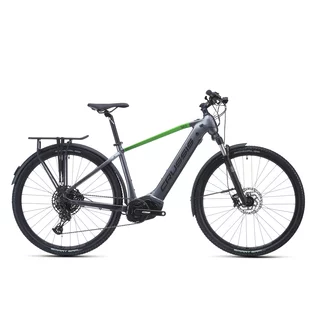Men’s Trekking E-Bike Crussis e-Gordo 9.11 715Wh 28” – 2026
2 399,60 €
In Stock
Compared products
2-year warranty
Men’s Trekking E-Bike Conway ECC 300 28” – 2017 is perfect for both short and longer rides. The Bosch engine powered by the 500Wh Bosch battery provides a long distance range. The 250W engine will make pedalling easier. However, to keep you safe, the engine stops when you reach the 25 kph speed. Aside from an aluminium frame, this bike has a number of other features such as the front and rear lights, rear luggage carrier, aluminium kickstand and mudguards. The 10-speed rear derailleur can be controlled using the lever shifter on the handlebars. The anatomically shaped Contec VL-3182 seat, comfortable Conway Riser handlebars, the Rock Shox suspension fork and reliable Schwalbe Marathon Mondial tires provide a high level of comfort during long rides. You may also appreciate the clear Bosch Intivia LCD display with controls on the handlebars that displays all the necessary information. Men’s Trekking E-Bike Conway ECC 300 28” – 2017 is perfect for in-town and moderate terrain riding.
Store the battery in shady and dry place with temperature between 10°C and 20°C. If you intend to stre the product for a longer period of time, charge it fully and recharge at least every 6 months up to 100% of its capacity.
As in all e-bikes, the distance range depends on the conditions such as the rider’s weight, terrain difficulty, weather, and the overall weight of the bike (the weight of the bike + the weight of the rider + the weight of the baggage). To calculate the maximum distance range, you can use the official BOSCH calculator.
Tips that might interest you:
Technical description:
|
Frame |
Conway, Alu 6061 |
|
Fork |
ROCK SHOX Paragon RL |
|
Rear derailleur |
Shimano Deore RD-M615 Shadow Plus |
|
Gear shifter |
Shimano Deore SL-M610 |
|
Brakes |
Shimano BR-M365, 160 mm, disc |
|
Cassette |
Shimano HG50, 11-36 z. |
|
Chain |
KMC X10e |
|
Handlebars |
Conway Riser, 660mm, Ø 31.8 mm |
|
Front hub |
Shimano HB-M3050 QR |
|
Rear hub |
Shimano FH-M3050 QR |
|
Rims |
Conway, HohlKammer X6, Disc |
|
Tires |
Schwalbe Marathon Mondial, 40-622, Reflex |
|
Seat |
Contec VL-3182, anatomic |
|
Seatpost |
Conway Patent |
|
Number of speeds |
10 |
|
Spokes |
Niro |
|
Engine |
Bosch Performance Cruise (250 Watt), central |
|
Battery |
Bosch 500 Wh |
|
Range |
up to 120 km (13,8 Ah) |
|
Sensors |
Pedaling intensity, speed |
|
Display |
Bosch Intuvia |
|
Accessories |
Front light, rear light, luggage carrier, kickstand,mudguards |
|
Wheel size |
28" |
|
Weight |
22.8 kg |
Battery storage and maintenance: We recommend storing the battery (or the entire product including the battery) in a shady, dry place at temperatures between 10 ° C and 20 ° C. If you do not intend to use the product for a long time, we recommend charging the battery and recharging it to 100% capacity at least once a month. Follow these guidelines to prevent the battery's nominal capacity from declining rapidly over its lifetime.
Note: The expected max. travel distance depends on various factors, such as the amount of electric assistance, user weight, terrain, wind and the inflation pressure, pattern and temperature of the tires. All stated travel distances are valid under optimal conditions, meaning even terrain with no wind, temperature of 20°C, extremely narrow tires with no profile and user weight under 70 kg.
| Battery | BOSCH 500 Wh |
|---|---|
| Number of charging cycles | 800 |
| Range | 120 km |
| Full capacity charging time | 3 h |
| Drive | Bosch |
| Motor | BOSCH Performance |
| Drive | Central |
| Motor output | 250 W |
| Brakes | Disc |
| Display | Intuvia |
| Gear shifting type | lever |
| Frame | Conway EMR Bosch Alu 6061 |
| Number of speeds | 10 |
| Suspension fork | yes |
| Frame material | Aluminium |
| Wheel size | 28 |
| Fork | ROCK SHOX Paragon RL |
| Rear Brake | Shimano BR-M365 160 mm |
| Front Brake | Shimano BR-M365 160 mm |
| Components set | Advanced components set |
| Type of e-bike | Trekking |
| Rear hub | SHIMANO FH-M3050 |
| Front Hub | SHIMANO HB-M3050 |
| Rear tire | Schwalbe Marathon Mondial 40-622 (28*1,5), Reflex |
| Front Tire | Schwalbe Marathon Mondial 40-622 (28*1,5), Reflex |
| Gear shifting | Shimano Deore SL-M610 |
| Weight | 22.80 kg |
| Rear Derailleur | Shimano Deore RD-M615 Shadow+ 10-Speed |
| Year | 2017 |
| Cassette | SHIMANO CS-HG50 10SPD 11-36 |
| Chain | KMC X10e |
| Front Rim | Conway Hohlkammer X6, Disc |
| Rear rim | Conway Hohlkammer X6, Disc |
| Brake levers | Shimano BL-M365 |
| Pedals | Contec CPI-046 |
| Handlebar grip | Conway Riser 660 mm, Ø 31,8 |
| Grips | Herrmans Grit |
| Handlebar stem | Conway A-Head |
| Saddle | Contec VL-3182 anatomic |
| Seat post | Conway Patent |
| Front Light | Axa Blueline 30, with a switch |
| Rear light | Büchel FL12 |
| Mudguards | SKS, Plastic |
We are sorry, but this product is no longer available.